Autonics TZN4M 매뉴얼 - 페이지 16
{카테고리_이름} Autonics TZN4M에 대한 매뉴얼을 온라인으로 검색하거나 PDF를 다운로드하세요. Autonics TZN4M 17 페이지. Dual pid control temperature controller
Autonics TZN4M에 대해서도 마찬가지입니다: 매뉴얼 (4 페이지), 사용 설명서 (2 페이지), 매뉴얼 (16 페이지), 매뉴얼 (16 페이지), 매뉴얼 (17 페이지)

Error Display
Display
Description
Blinks when input is disconnected.
OPEN
Blinks when the measured input value is higher than the temperature range.
HHHH
Blinks when the measured input value is lower than the temperature range.
LLLL
Proper Usage
Troubleshooting
Symptoms
Troubleshooting
Disconnect the power and check the input connection.
If the input is connected, disconnect the input wiring from the temperature controller and short the
OPEN is displayed on
+ and - terminals. Power the temperature controller and check if it displays the room temperature.
the PV display during
If it does not display the room temperature and continues to display OPEN, the controller is broken.
operation
Please contact our technical support. (Input type is thermocouple)
Check the state of the control output indicator on the front panel.
Load (heater, etc.)
If the indicator is not working, check parameter settings. If the indicator is working, disconnect the
does not operate
wiring from the output terminal of the temperature controller and check the output (replay contact,
during operation
SSR drive, current).
ERR0 (error) is
displayed on the
Indicates damage to internal chip by strong noise (2kVAC).
PV display during
Please contact our technical support. Locate the source of the noise and devise countermeasures.
operation
Cautions during use
Follow instructions in 'Cautions during Use'. Otherwise, It may cause unexpected accidents.
Check the polarity of the terminals before wiring the temperature sensor.
For RTD temperature sensor, wire it as 3-wire type, using cables in same thickness and length.
For thermocouple (CT) temperature sensor, use the designated compensation wire for extending wire.
Keep away from high voltage lines or power lines to prevent inductive noise.
In case installing power line and input signal line closely, use line filter or varistor at power line and shielded
wire at input signal line.
Do not use near the equipment which generates strong magnetic force or high frequency noise.
Install a power switch or circuit breaker in the easily accessible place for supplying or disconnecting the
power.
Do not use the unit for other purpose (e.g. voltmeter, ammeter), but temperature controller.
When changing the input sensor, turn off the power first before changing.
After changing the input sensor, specify internal switch and modify the value of the corresponding parameter.
Do not overlapping communication line and power line.
Use twisted pair wire for communication line and connect ferrite bead at each end of line to reduce the effect
of external noise.
Make a required space around the unit for radiation of heat.
For accurate temperature measurement, warm up the unit over 20 min after turning on the power.
Make sure that power supply voltage reaches to the rated voltage within 2 sec after supplying power.
Do not wire to terminals which are not used.
This unit may be used in the following environments.
①Indoors (in the environment condition rated in 'Specifications')
②Altitude max. 2,000m
③Pollution degree 2
④Installation category II
Dual PID Control
Troubleshooting
Check input status.
Adjust the value to within the
temperature range.
SENSORS
CONTROLLERS
MOTION DEVICES
SOFTWARE
(J)
Temperature
Controllers
(K)
SSRs
(L)
Power
Controllers
(M)
Counters
(N)
Timers
(O)
Digital
Panel Meters
(P)
Indicators
(Q)
Converters
(R)
Digital
Display Units
(S)
Sensor
Controllers
(T)
Switching
Mode Power
Supplies
(U)
Recorders
(V)
HMIs
(W)
Panel PC
(X)
Field Network
Devices
J-155
